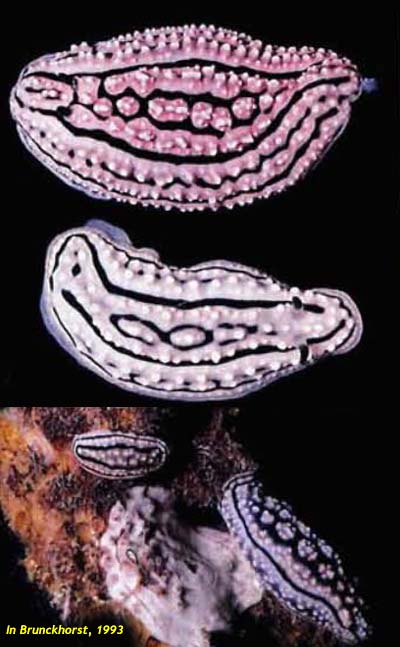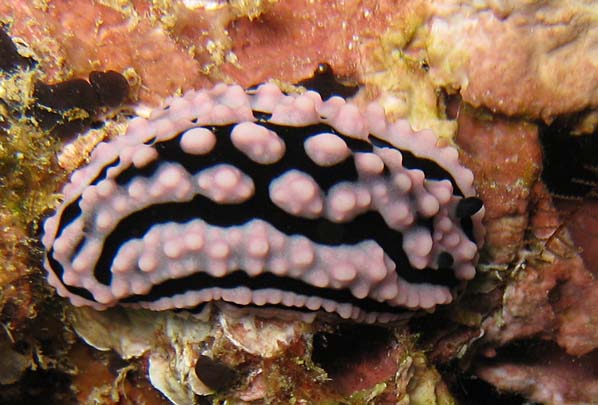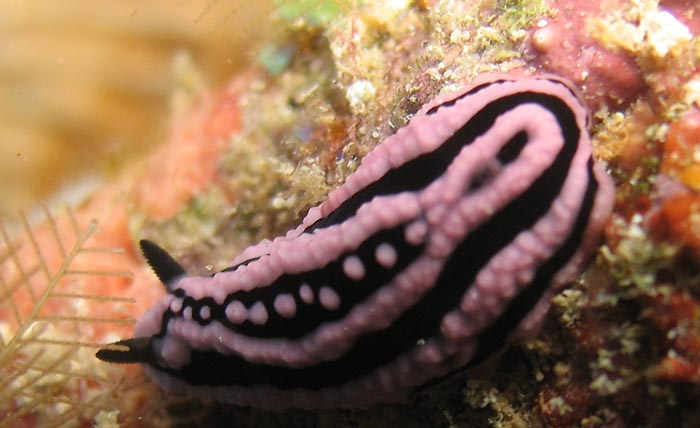This species has been observed on Reunion, Mayotte, Madagascar and Seychelles Islands
Remarks :
![]() There is in our region a group of nudibranchs that I will call Phyllidiella meandrina/rosans/zeylanica difficult to identify, for two reasons: on the one hand the existence of many intermediate forms and on the other hand the very marked differences of opinion between specialists about these species ... I finally decided to make a classification (very questionable) of these specimens
There is in our region a group of nudibranchs that I will call Phyllidiella meandrina/rosans/zeylanica difficult to identify, for two reasons: on the one hand the existence of many intermediate forms and on the other hand the very marked differences of opinion between specialists about these species ... I finally decided to make a classification (very questionable) of these specimens
- Group Phyllidiella rosans : There are 6-9 rounded, longitudinal pink ridges which are relatively smooth
- Group Phyllidiella cf. rosans : Up to nine rounded, longitudinal pink ridges which are relatively smooth with with surnumerous pink tubercules
- Group Phyllidiella meandrina : In the central part of the mantle there a characteristic pattern of pink to grey-blue rings
- Group Phyllidiella cf. meandrina : The disposition of the tubercles looks like P. meandrina but there are transverse black area beetween the tubercles all over the notum
- Group Phyllidiella zeylanica : In adult, up to nine longitudinal pink ridges (broken or interrupted) may occur and medially, presence of a more or less developed network of black band around the tubercles
Bibliographic data : Material examined by David J.Brunckhorst ( see references/publications).
Other external morphology characteristics
|
 |
Similar species
Phyllidiella zeylanica is rather similar in colour and pattern to Phyllidiella rosans.
Live specimens ranged in length from 18-35 mm .
There are 6-9 longitudinal pink ridges.
The tubercules are rounded, which gives a relatively smooth aspect to the pink ridge
Only longitudinal black lines.
The rhinophores are black with the black pale pink and each rhinophoral clavus possesses 12 to 15 black lamellae (specimens greater than 30mm).
The gills and oral tentacles are pale grey.
The pale grey foot sole has numerous tiny, dark grey spots.
Live specimens ranged in length from 5-60 mm
Up to nine longitudinal pink ridges.
The ridges are formed from the coalesced bases of compound tubercles which give a very tuberculate, uneven and irregular aspect to the pink ridge.
Sometimes there are some cross-bars of black lines.
The rhinophores are black and each rhinophoral clavus possesses 20 to 23 lamellae (specimens greater than 30mm).
The gills and oral tentacles are dark grey.
The foot sole is white.
Phyllidiella zeylanica is a little similar to Phyllidiopsis gemmata but Phyllidiella zeylanica have a submarginal black line around the mantle edge ( not present in Phyllidiopsis gemmata ). And Phyllidiopsis gemmata have only four longitudinal black lines, the outer most black lines extend to the mantle edge anteriorly and posteriorly.
References :
Bill Rudman Seaslug site : Sea Slug Forum : Phyllidiella zeylanica
Publications :
Brunckhorst, D.J. (1993) The systematics and phylogeny of Phyllidiid Nudibranchs (Doridoidea). Records of the Australian Museum, Supplement 16: 1-107.
Other photos of Phyllidiella zeylanica :
|
|
Christophe Cadet Reunion, March 2010, size : 15 mm
|
Matthias Deuss Mayotte, Passe en S, 17 m, 23 December 2009, size : 35 mm
|
 |
|
|
Matthias Deuss Mayotte, Passe en S, 10 m, 23 December 2009, size : 35 mm
. |
Norbert Verneau Mayotte, Dzaoudzi, le banc de sable, 6 m, 14 September 2012, size : 25 mm
|
 |
 |
Florence Trentin Mayotte, Bandrélé, 5 August 2006, |
Maurice Jay Reunion, Juvenile form of Phyllidiella zeylanica Juveniles possess one or two, narrow, encircling ridges of mostly rounded tubercles around the mantle margin and a single large, elongate, amalgamated mass of tubercles medially. |
 |
 |
Norbert Verneau Mayotte, Dzaoudzi, le banc de sable, 4 m, 14 September 2012, size : 30 mm
|
Florence Trentin Mayotte, Passe Bateau, 1 August 2006, size : 15 mm
. |
|
|
|
Christophe Mason-Parker Seychelles, Mahe, Baie Ternay, 3 m, 23 July 2011
. |
More photos from Indian Ocean
If you have taken a photo of this species in South West Indian Ocean, please Contact us...




